Pests, predators and taking it easy with the spray.
Yes, this is another post about letting nature take its course when it comes to pests. I'm getting into teaching about organic, pesticide free bug control and will write about it often as I clarify my thoughts.
I’ll admit it – I’m a lazy gardener. Lots of necessary, physical work by Jelina, Marlon and myself went into establishing the bones of Ligaya Garden but that’s done now. There are still a few large scale plans for the place but they’ll take professional work and substantial investment to get done. We’ve done most of the achievable things that we planned.
Now it’s time to let the garden do its thing. The plants are all in, trees grown and bearing fruit, flowers, veggies and medicinal awaiting harvest. It’s a pretty good time and the creatures that share our space are finding a balance. I like to let them do that because it makes my life much, much easier.
Little by little, Ligaya Garden has been colonised. Not by Jack booted invaders or ferocious folks waving Union Jacks but by lots and lots of tiny, welcome friends. At first, there were many pest problems as we were invaded by critters who liked nothing more than the thought of munching on our leafy greens and anything else, afterall, we had created an artificial ecosystem that had no defenders beside us – the young plants were a magnet for every pest under the Sun and I was kept busy jumping from one outbreak to another. Sometimes, though, we got to eat some of the plants ourselves.
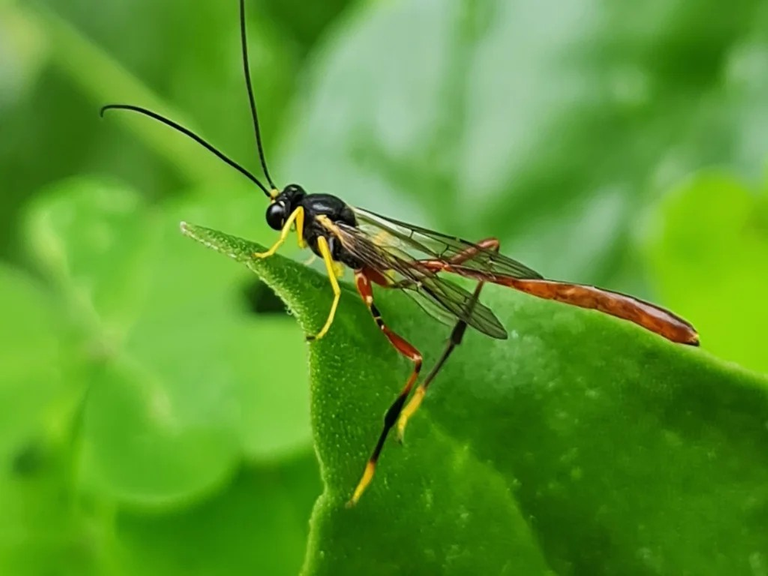
Predatory Wasps are everywhere!
Enter the predators. At first, I was aware of the birds who flew in and out of our garden, snapping up pests on the wing or digging through our mulch (and usually kicking it onto our paths). Then, I saw a cloud of Hoverflies around our Crassula plant. That plant got divided and repotted and now its offspring are key parts of the garden ecology.
I found weird looking caterpillar cocoons and learned about predatory wasps, saw myriads of dead aphids and learned about the huge number of insects who make their dinner from living ones.
As the garden matured and I learned its secrets, I saw many weird and wonderful critters and slowly unravelled their places in the tapestry of the garden. I saw which were the pests and which were the predators. It was slow learning as many insects who may be prey mimic other insects who may be predators. One big realisation was that the juvenile form of many insects look nothing like their parents! Ladybirds are a classic example, the almost spiny, lumpy, terrible looking larvae look nothing like their pretty beetle parents. Hoverfly larvae look nothing like hoverflies either. Then there were ‘instars’ to learn about. Instars are the stages of growth of a young insect and are marked by shedding the inflexible old exoskeleton as the juvenile insect grows beyond its limitations. Most insects change some aspect of their appearance between moults – they can change colour, markings and even body shape.
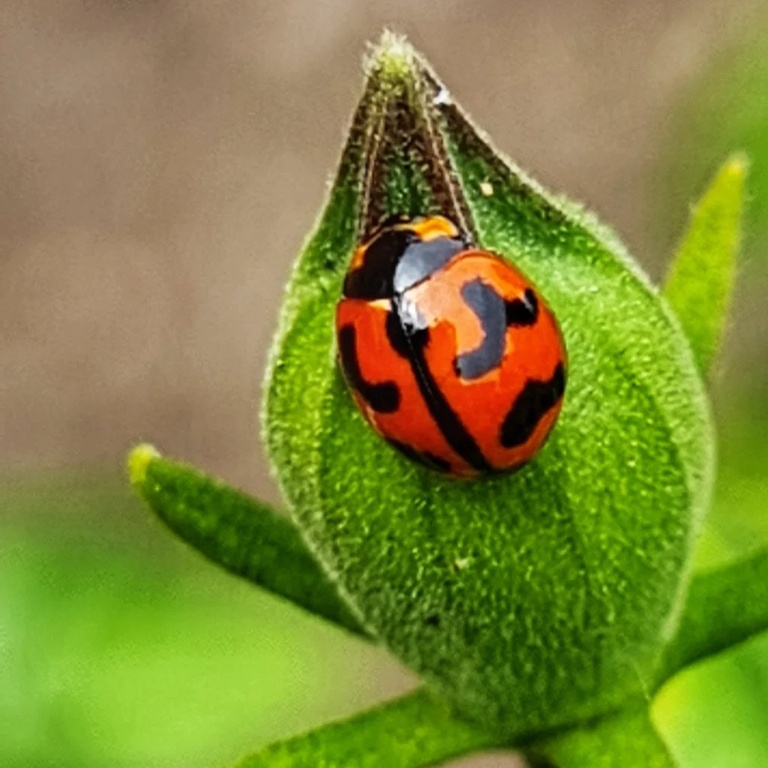
The adult Ladybird
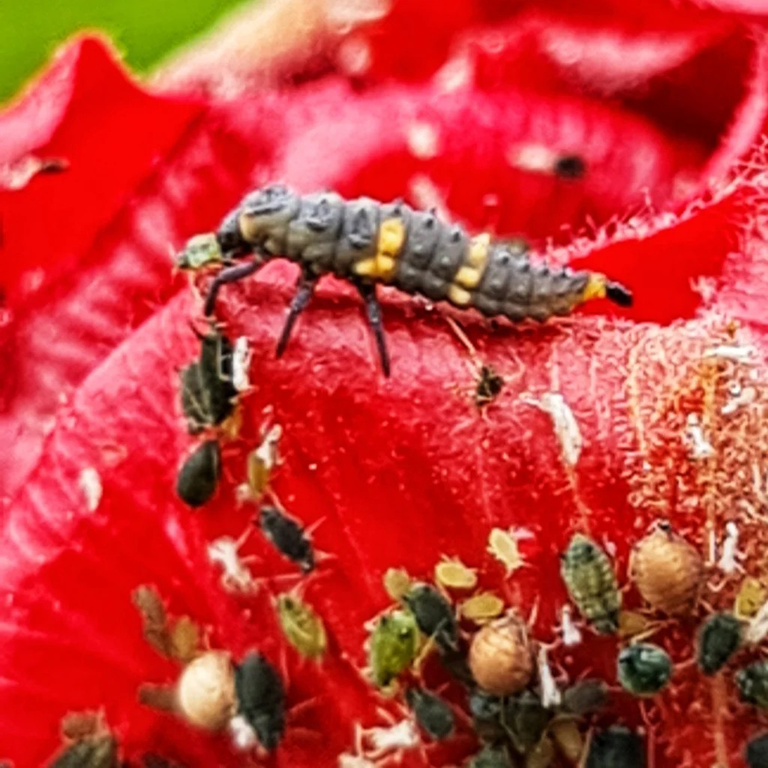
looks nothing like the juvenile
The changes with new instars are not just physical. Insects can change behaviour as they mature. They can change their favorite food source, where they prefer to hunt or hide, many even learn to fly!
Learning so much lead me to realise that there are even more critters out there in the foliage that I never see. They could be pests or friends but I haven’t seen them yet. I’ve found so many by sheer accident and I know that every movement I make in the garden affects them.
We’ve always been light on pest sprays, avoiding the chemical ones and choosing the ‘environmentally’ friendly options but I got to thinking that the products are all made from chemicals in huge factories, contained in plastic containers, wrapped in more plastic, then shipped to the shelves in my local garden centres. There had to be a better way.
I started making more of my own pesticides. All the usual favourites- soap, Garlic and Chili mixes, Turmeric, White Oil. They helped but I got to thinking one day and had the obvious epiphany that sprays are indiscriminate and affect more than just the bugs you want to eliminate. A ‘pesticide’ is just an ‘insecticide’ and all beneficial bugs are insects so my efforts were probably taking down a few of the good bugs too.
I decided that except for overwhelming infestations on plants that we really needed to eat to stay alive, I would take a hands-off approach. I would let Nature make a balance.
It didn’t take long for the garden to achieve that balance. It took about 2 years to find the happy place between lost seedlings, chewed leaves and a population of predators but I persevered. It was a frustrating, panic inducing time but we made it.
Now our losses are negligible. We have some holes and chewed edges, damaged leaves or a spoiled piece of fruit from time to time but far, far less than before. I’ve learned when the cycles of pests come so am prepared to use the minimum of work to deter them while predator populations are hatching out and getting to work.
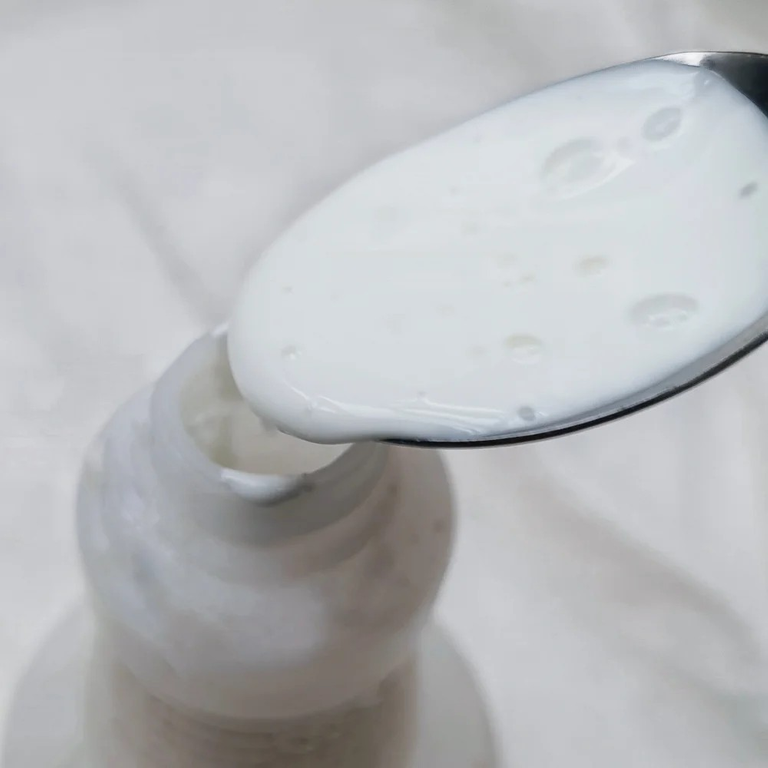
Homemade white oil
I still make a batch of White Oil here and there but a litre of it lasts me many months. Water spray knocks many populations into oblivion and agile fingers combined with hard soled shoes take care of many individuals. I do admit to using the ‘safe’ Slug and Snail pellets in the bioponics system every time the season changes. At those times, large numbers of tiny Slugs make their way from their hiding places deep in the grow media and rush (as much as a Slug can ‘rush’) straight to the new season’s seedlings. Traditional alternatives such a beer traps just don’t seem to work. Maybe the Slugs are too young to have acquired a taste for the stuff (I remember that I didn’t start to enjoy it until I was in my 20s. What is that in Slug time)? The bioponics beds are well off the ground and netted, so that eliminates the chance that animals and birds may accidentally ingest some
This year I have learned that I can limit the Slug damage by paying attention to the timing of the plantings and by letting seedlings grow a little bigger before transferring them to the bioponics beds. This year, I used about a 3rd of the pellets that I did the year before. Hopefully by, as the permies say ‘observing and interacting’, I can eliminate them altogether next year.
I have learned which plants different pests attack first. Red Spider Mites always hit the potted Pepino in the back yard before I see them anywhere else. Crusader Bugs prefer the Orange tree and head there before they develop a taste for Mandarines, the same is true for Citrus Leaf Miners.
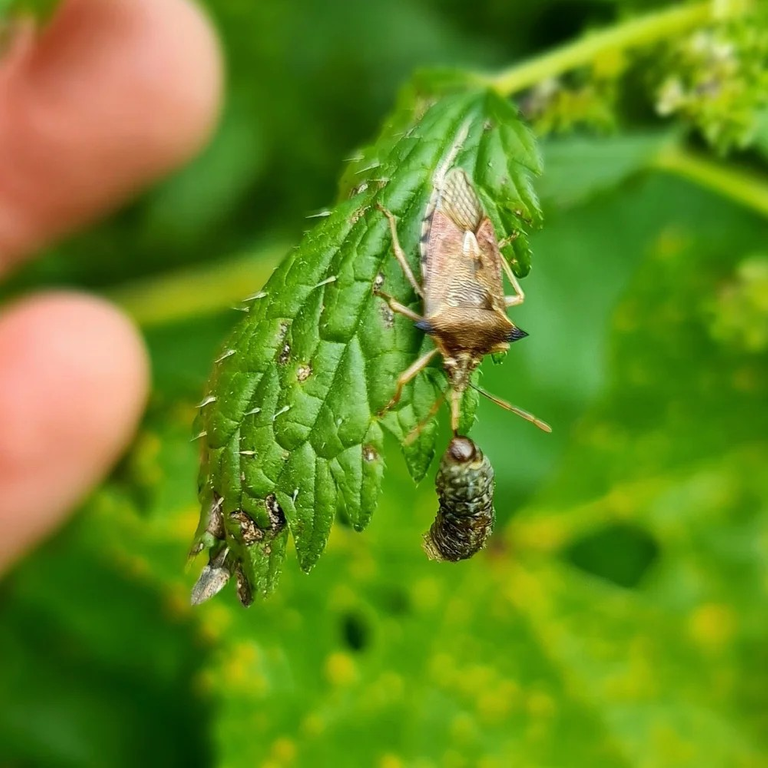
A Spined Soldier Bug was seen sucking the insides from a caterpillar
The real excitement is when I discover a previously unseen predator in the garden. I saw a Lacewing larva the other day carrying its camouflaging bundle of dead victims. A Spined Soldier Bug was seen sucking the insides from a caterpillar and I discovered that we not only have Hoverflies, but that we have two species at our place and there’s another in a nearby garden. I hope that I can lure them to ours!
Plant nutrition is the next thing to focus on. I’ve always well fertilized our garden with generalised, home made fertilisers but I’m getting into much more specific information. Its not quite true that pests won’t attack a healthy plant but a healthy plant has less chance of attracting them, a better shot at fighting them off and will recover much faster once they’re gone.

Companion planting is the go!
Companion planting is another key. In general, strong smelling plants deter pests from attacking them or nearby plants. At Ligaya Garden, one of our Lavenders and a Wormwood grow right through the lower branches of our Mandarin tree, bringing pollinators and deterring many invaders. We’ve not had problems with Nematodes but plant Tagetes in different places every year to deter them from the soil. Their strong smell deters other things too. Many companion plants have the double benefit of attracting beneficial insects too.
Our garden design incorporates dense interplanting and I think that I think that interplanting densely with a wide mix of species simply confuses the buggers on arrival.
Of course, I haven’t done all this by observation and interaction in the classic sense. There are hundreds of great insect identifying guides on the Web. My favorite book on the topic is ‘Garden Pests & Good Bugs’ by Denis Crawford, published by ABC books. I like this guide because it is Australian and it is aimed at garden pests, so it ticks two boxes for me. It is very well illustrated, both pests and predators in detail and has a section on diseases. It’s my go to book for garden insects.

My go-to book on garden insects
As I’ve mentioned in other posts, you don’t have to go as deeply into everything as we do here, I just love learning and have the time but maybe you’re too busy with a job and kids to focus. I’ll keep posting for you what I observe and learn. I’m even creating new posts and a page dedicated to the topic of pest control. There’ll be a new item added to the menu bar soon so that you’ll have no trouble finding them.







In some ways this post makes me tired. I know I have to get to know the bugs better but it's just more stuff to fill me head. I don't use any spray because I can't be bothered. I do use dichotomous earth but you are right, I'd be better to let the seedlings grow bigger first.... All this rain I haven't been in garden and things are doing their thing and maybe it'll all just be fine without much effort from me..
Learning about the insects one of those things that saves an enormous amount of time and energy later on.
Gardening has been restricted a bit here too because of the rain.
Great post. thanks
Thank you!
I love garden predators 👍👍👍
!1UP
They're the best!
You have received a 1UP from @gwajnberg!
@ctp-curator, @stem-curator, @vyb-curator, @pob-curator
And they will bring !PIZZA 🍕.
Learn more about our delegation service to earn daily rewards. Join the Cartel on Discord.
Hooray! Thanks
I gifted $PIZZA slices here:
@curation-cartel(17/20) tipped @ligayagardener (x1)
Join us in Discord!
Thank you @pizzabot
The photography of all these creatures are nice. You had a beautiful capture. Some of the varieties of these insects are pests and therefore their distructive nature help us to study more about their physiology and how they operate.
Thank you for that. I have a good camera on my phone.
I find your posts to ne informative and well written. I'd love to include them all in the Garden Shed but have to look around for others.